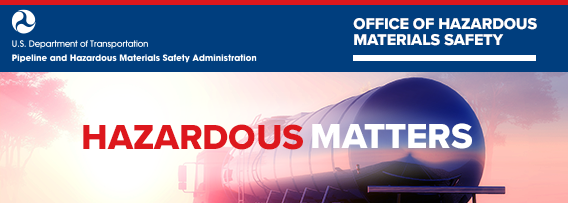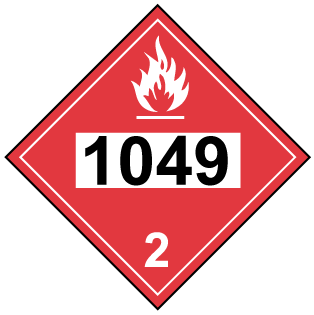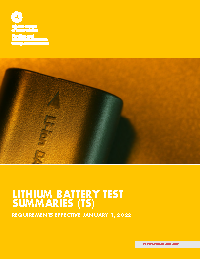Hazardous Matters October December - 2024

"Hazardous Matters" is the quarterly newsletter for PHMSA's Office of Hazardous Materials Safety (OHMS). As always, it is packed with the latest news, expert tips, and essential insights for the safe handling and shipment of hazardous materials. Stay informed, stay safe!
October - December 2024
Attention First Responders: Hydrogen Awareness
On February 11, 2018, a tube trailer containing hydrogen caught fire in Diamond Bar, CA. The incident, caused by the incorrect installation of a burst disc into the cylinder, resulted in the evacuation of up to 2,000 people and $175,000 in equipment damage. The subsequent NTSB investigation revealed that the appearance of the trailer posed a challenge to on-scene responders, as the tube trailer itself was housed within a box-truck-style cabinet. The cabinet enclosure did not present the first responders with the typical visual cues that would indicate the presence of a high-pressure gas, such as bundles of long cylinders mounted on the open framework chassis of a tube trailer.
The need to improve emergency response for incidents involving hydrogen gas, as emphasized in the Diamond Bar NTSB report, will only grow as hydrogen becomes an increasingly important part of the future energy economy of the United States. The 2021 Bipartisan Infrastructure Law invested over 8 billion dollars in creating regional clean hydrogen hubs to grow this sector.
As hydrogen becomes more prevalent, we must be prepared for incidents involving hydrogen gas in transportation, and the unique challenges it poses to emergency responders. First, hydrogen fires are difficult to detect because they burn with an invisible flame. Emergency responders may need to use an alternate method of detection, such as a thermal camera or broom handle, to detect a hydrogen fire. The Pacific Northwest National Laboratory (PNNL) has done significant work to characterize the risks posed by hydrogen incidents, and to provide emergency responders with training modules to help prepare for, and better protect themselves during, response to these incidents.
 Another challenge, as demonstrated by the Diamond Bar incident, is that some containers (i.e., packages) used for hydrogen transportation may look different than those used for other flammable gases. For example, a common method of transportation for high-pressure gases, like hydrogen, is in a large, open-sided trailer known as a "tube trailer," which allows responders to visually identify the presence of high pressure compressed gas cylinders at a glance. However, tube trailers in hydrogen service can look different, and may appear to be a common box-truck. Responders should rely on hazard communication on the vehicle, such as the on the exterior of the truck, to aid in hazard identification.
Another challenge, as demonstrated by the Diamond Bar incident, is that some containers (i.e., packages) used for hydrogen transportation may look different than those used for other flammable gases. For example, a common method of transportation for high-pressure gases, like hydrogen, is in a large, open-sided trailer known as a "tube trailer," which allows responders to visually identify the presence of high pressure compressed gas cylinders at a glance. However, tube trailers in hydrogen service can look different, and may appear to be a common box-truck. Responders should rely on hazard communication on the vehicle, such as the on the exterior of the truck, to aid in hazard identification.
The Pipeline and Hazardous Materials Safety Administration (PHMSA) is committed to ensuring that the coming hydrogen energy economy develops safely. Our Office of Hazardous Materials Safety (OHMS) has collaborated with the Hydrogen Safety Panel, and works closely with the Department of Energy Hydrogen Interagency Task Force (HIT) Infrastructure, Siting and Permitting (ISP) Working Group. As hydrogen transport grows, we will continue to engage with emergency response community to share lessons-learned from incidents and accidents, and to incorporate the appropriate guidance into the Emergency Response Guidebook.
Spotlight: Seeking Award Submissions
The TRB Committee on the Transportation of Hazardous Materials (AT040) created the Charlie H. Hochman Outstanding/Lifetime Achievement Award and an Outstanding Paper, Research, or Contribution Award in 2015 to recognize outstanding achievements in the advancement of hazardous materials research, innovation, regulation, or management. Committee AT040 will accept nominations until November 8, 2024 for awards to be considered for and presented at the 104th TRB Annual Meeting in Washington, DC.
Please refer to the AT040 Committee Website at https://sites.google.com/site/trbcommitteeat040/awards for more information about these awards and the nomination process. Nominations may be sent to Britain.Bruner@dot.gov.

Final Rule: FAST Act Requirements for Real-Time Train Consist Information
On June 24, PHMSA published HM-263 "Hazardous Materials: FAST Act Requirements for Real-Time Train Consist Information" to the Federal Register. This final rule requires railroads that carry hazardous materials to generate train consist information in electronic form, maintain that information off-the-train, and update that information in real-time. Railroads must provide that information to authorized federal, state, and local first responders, emergency response officials, and law enforcement personnel along the train route who could be involved in the response to an incident.
The amendments in this final rule address a safety recommendation of the National Transportation Safety Board and statutory mandates in The Fixing America's Surface Transportation Act, as amended by the Infrastructure Investment and Jobs Act.
Though voluntary compliance can begin immediately, this rule provides the following delayed compliance dates:
- Class I Railroads: June 24, 2025
- Class II and III Railroads: June 24, 2026
Notice of Public Meetings: International Standards on the Transport of Dangerous Goods
PHMSA's OHMS will be hosting public forums in advance of four international meetings to allow the public to give input on current proposals being considered by the International Civil Aviation Organization's (ICAO) Dangerous Goods Panel (DGP) and the United Nations Sub-Committee of Experts on the Transport of Dangerous Goods (UNSCOE TDG). The meetings include the following, with the public meetings held approximately two weeks before the corresponding international meeting:
- Public Meeting in preparation for the ICAO Dangerous Goods Panel, Working Group 2024, October 8, 1 PM – 3 PM EDT (virtual)
- ICAO TDG Working Group 2024 (WG/24), scheduled for October 21-25, in Montreal, Canada
- Public Meeting in preparation for the 65th Session of the UN Sub-Committee of Experts on the Transport of Dangerous Goods (TDG), November 13, 9 AM – 12 PM EDT (hybrid)
- The 65th session of the UNSCOE TDG, scheduled for November 25 to December 3, 2024, in Geneva, Switzerland.
Specific information for each meeting, including date, time, conference call-in number, and details for advance registration has been posted on PHMSA's website under "Upcoming Events." In-person meetings are held at U.S. Department of Transportation (DOT) Headquarters in Washington, DC (1200 New Jersey Avenue SE, West Building).
The Federal Register announcement can be found here.
Interested in being the first to know when PHMSA posts notices and rulemakings to the Federal Register? Receive email notifications from the Federal Register whenever PHMSA posts by visiting the Federal Register site and clicking 'Subscribe' at https://www.federalregister.gov/agencies/pipeline-and-hazardous-materials-safety-administration.

Hazmat Transportation Seminar (in-person)
 PHMSA will be hosting a free, in-person seminar on hazardous materials transportation, October 30 through November 1 at the Hyatt Regency in Indianapolis, Indiana. The event will consist of two tracks: one to assist hazmat professionals in all industries with their compliance needs, the other to apprize first responders of the latest in hazmat response. Working in conjunction with the Indianapolis Small Business Development Center, we welcome small, veteran-owned, and minority-owned businesses—even if you're new to the hazmat world!
PHMSA will be hosting a free, in-person seminar on hazardous materials transportation, October 30 through November 1 at the Hyatt Regency in Indianapolis, Indiana. The event will consist of two tracks: one to assist hazmat professionals in all industries with their compliance needs, the other to apprize first responders of the latest in hazmat response. Working in conjunction with the Indianapolis Small Business Development Center, we welcome small, veteran-owned, and minority-owned businesses—even if you're new to the hazmat world!
Sessions will focus on developing a DOT training program, hazardous materials shipping papers, incident reporting, placarding, marking, labeling, proper hazmat packaging, incident case studies, the ERG 2024, hazmat response sessions for highway and rail incidents, and more. Speakers will include experts from PHMSA, the Federal Motor Carrier Safety Administration (FMCSA), the Federal Railroad Administration (FRA), and TRANSCAER. Visit the Federal Register announcement for more details.
Register for free, here: https://opsweb.phmsa.dot.gov/hm_seminars/default_workshop.asp
Webinar: "US DOT Nurse Tank Safety Advisory Discussion"
In August 2023, an anhydrous ammonia nurse tank experienced a catastrophic failure in a farm co-op lot, with the tank shell "rocketing" over 300 feet from its original location. Following this incident, PHMSA and the Federal Motor Carrier Safety Administration (FMCSA) published the Safety Advisory "Possible Catastrophic Failure of Nurse Tanks and Recommendation for Periodic Testing."
PHMSA and FMCSA experts will be taking part in a webinar discussing this safety advisory on Tuesday, October 15, from 2-3 PM ET, hosted by the Agricultural Retailers Association (ARA). The webinar is intended for those in the agricultural sector, will cover the details of the safety advisory, types of tests recommended by the advisory, what to do if a nurse tank fails one of these tests, and how to repair a nurse tank (if repairs are authorized).
Register here: https://us06web.zoom.us/webinar/register/WN_kRWoOkKoQICmvZiTrTECwA.

UN Test Summaries (updated)
 For safety reasons, lithium batteries must be subjected to a series of design tests per sub-section 38.3 of the UN Manual of Tests and Criteria. To help downstream shippers and consumers verify these tests, the HMR require manufacturers and subsequent distributors of lithium cells or batteries manufactured on or after January 1, 2008, to make available the test summary.
For safety reasons, lithium batteries must be subjected to a series of design tests per sub-section 38.3 of the UN Manual of Tests and Criteria. To help downstream shippers and consumers verify these tests, the HMR require manufacturers and subsequent distributors of lithium cells or batteries manufactured on or after January 1, 2008, to make available the test summary.
With HM-215Q, PHMSA excepted button cell batteries installed in equipment (including circuit boards)—such as wrist watches and key fobs—from the test summary requirement. To account for this change, we have updated our UN Test Summaries brochure, to better assist manufacturers and distributors with understanding the lithium battery test summary requirement.
Link: https://www.phmsa.dot.gov/training/hazmat/new-un-requirement-test-summaries
Check the Box: Updated Fact Sheets
 Since 2018, the Check the Box campaign has sought to prevent serious incidents by raising awareness of the risks of undeclared hazardous shipments by providing compliance aid resources to the general public. This year, PHMSA reviewed our data on undeclared hazmat incidents, and updated our fact sheets devoted to the four most common undeclared materials.
Since 2018, the Check the Box campaign has sought to prevent serious incidents by raising awareness of the risks of undeclared hazardous shipments by providing compliance aid resources to the general public. This year, PHMSA reviewed our data on undeclared hazmat incidents, and updated our fact sheets devoted to the four most common undeclared materials.
We have updated the following fact sheets, providing visual improvements, including current examples, and incorporating new content—like a guide to identifying damaged lithium batteries!
- Check the Box for Lithium Batteries
- Check the Box for Dry Ice
- Check the Box for Aerosols
- Check the Box for Flammable Liquids
PHMSA develops compliance assistance materials that make it easier to understand and comply with the HMR. Electronic versions of these resources are available at: https://www.phmsa.dot.gov/training/hazmat/publications.
